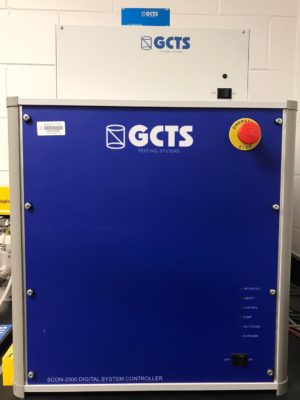

Description
The GCTS setup facilitates the use of bender element, a non-destructive test, to determine the small-strain shear modulus (Gmax) of the soil as per ASTM D8295-19. This test method involves the bender elements mounted in the top platen and base pedestal of a triaxial test specimen to measure shear wave velocity in the vertical direction.
Specifications
This system includes receiver and transmitter bender elements, function generator, and digital oscilloscope. The procedure for the test is fully automated through the software. Some System features are:
- Ultrasonic velocity measurement of compression (P wave velocity) and shear (S wave velocity) waves in the soil specimen
- Smart software features for accurate measurement of wave velocities
- Digitally controlled pulser and receiver
- State-of-the-art software for data acquisition, analysis, storage, plotting, and reporting
- Sampling rate: 156 Hz to 40 MHz
- Resolution: 16-bit
Material Properties
One of the elements acts as a transmitter and the other as a receiver. By knowing the distance of travel is the tip-to-tip distance between the two bender elements, the speed of the shear wave, Vs, can be determined as:
Vs = L ⁄ t
Where t is the time of travel and L is the distance that the wave travels. L can be taken as the distance between the tips of the two bender elements (transmitter and receiver).
The small-strain shear modulus, Gmax, is then calculated by the following equation:
Gmax = ρV2s
Where ρ is the bulk density of the soil.
Application
- The initial shear modulus (Gmax) of a soil specimen under particular stress and time conditions is an important parameter in small-strain dynamic analyses such as those to predict soil behavior or soil-structure interaction during earthquakes, explosions, and machine or traffic vibrations.
- Gmax can be equally important for small-strain cyclic situations such as those caused by wind or wave loading.
- Small-strain Gmax is also vital for non-linear analyses of large strain situations, where the larger strain soil stiffness results could come from torsional shear tests.
- Shear wave velocity and Gmax can be used to compare different soil specimens in a laboratory testing program, and also for comparing laboratory and field measurements of these parameters
Publications
- Chakraborty, Sayantan, Aritra Banerjee, Jasaswee T. Das, Leila Mosadegh, and Anand J. Puppala. “Impact of variation of small strain shear modulus on seismic slope stability analysis of a levee: A sensitivity analysis.” In IFCEE 2018, pp. 302-313. 2018.
- Hoyos, L. R., E. A. Suescun, and A. J. Puppala. “Small-strain stiffness of unsaturated soils using a suction-controlled resonant column device with bender elements.” In Geo-Frontiers 2011: Advances in Geotechnical Engineering, pp. 4313-4322. 2011.
- Hoyos, L. R., P. Takkabutr, A. J. Puppala, and Md S. Hossain. “Dynamic response of unsaturated soils using resonant column and bender element testing techniques.” In Geotechnical Earthquake Engineering and Soil Dynamics IV, pp. 1-8. 2008.
- Puppala, Anand J., Rupesh Kadam, Raja S. Madhyannapu, and Laureano R. Hoyos. “Small-strain shear moduli of chemically stabilized sulfate-bearing cohesive soils.” Journal of Geotechnical and Geoenvironmental Engineering 132, no. 3 (2006): 322-336.
- Puppala, Anand J., Venkat Bhadriraju, Raja Sekhar Madhyannapu, Soheil Nazarian, and Richard Williammee. “Small strain shear moduli of lime-cement treated expansive clays.” In Geomechanics II: Testing, Modeling, and Simulation, pp. 58-70. 2006
